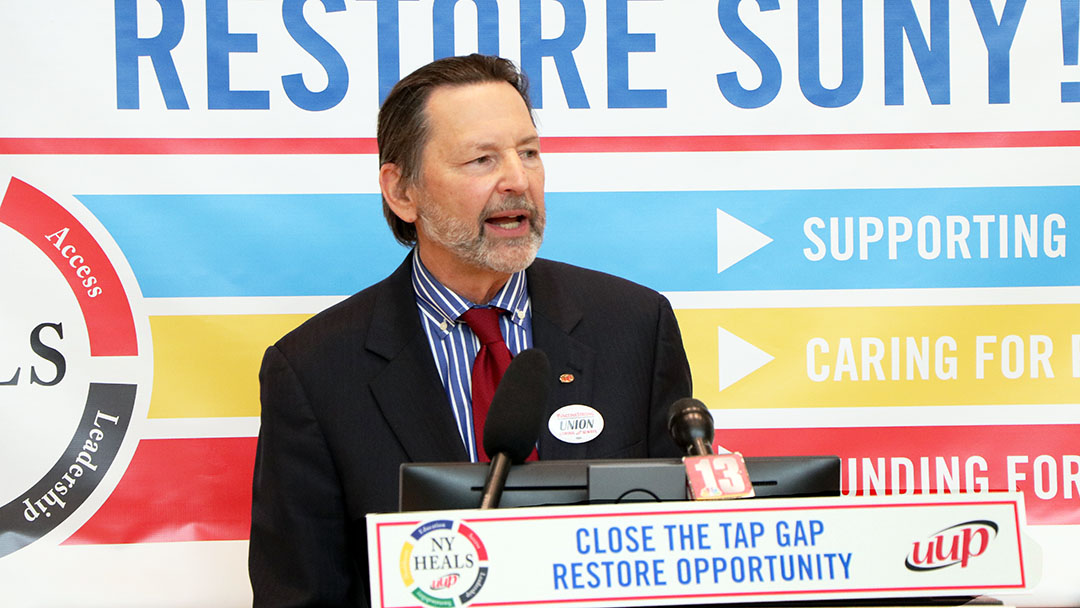December 1, 2021

Click HERE to view video of the press conference.
UUP leaders made impassioned cases Nov. 30 in back-to-back events for two of SUNY’s most dire needs: the TAP Gap and SUNY’s COVID-racked hospitals, where the staff had enough protective gear only because UUP spent $1 million to buy it.
“The time is now to make TAP whole,” UUP President Fred Kowal said during a late morning press conference at the University at Albany on the TAP Gap, which represents the difference between the maximum award of the state’s Tuition Assistance Program and the cost of a year at SUNY.
Less than two hours later, Kowal sat before members of the State Assembly Higher Education Committee for a hearing on the effects of the coronavirus pandemic on the future of higher education in New York.
Kowal had also testified Nov. 22 before the state Senate Committee on Higher Education, on the same topic. He told both committees in blunt language that more than a decade of starvation funding for SUNY—including the TAP Gap, which drains resources that should be used for academic and student services—is driving away students, faculty and staff.
Few resources; fewer faculty and staff
“It has been a longstanding issue throughout my membership that people feel burned out,” Kowal told the Assembly members. “What I’m hearing from our members is people are burned out; they are at their limit. We hear a lot about under-enrollment. The problem is students are not getting the help, the resources they need on these underfunded campuses.”
The press conference packed a large meeting room with students and advocates for SUNY, and also drew an impressive speaker’s lineup of state lawmakers, student advocates and UUP leaders.
At issue: The maximum annual TAP award is $5,665, and even students who qualify for the full amount can come up as much as $1,570 short on tuition and fees. For the past 11 years, the state has expected individual campuses to cover that shortfall, a requirement that has stretched the smaller SUNY colleges to the limit.
Make TAP whole now
Last year’s state budget included a plan to make TAP whole within three years. But given the vastly improved state budget outlook this year, and the millions of dollars of federal pandemic aid that flowed into New York, “the time is now to make TAP whole,” Kowal said during the press conference.
Joining Kowal at the podium were Aaron Major, Albany Chapter president and a member of the UUP Negotiations Team; Assembly members John McDonald (D-Cohoes) and Phil Steck (D-Colonie); Albany Common Council member Owusu Anane, a UAlbany alumnus and a graduate of the Educational Opportunity Program; Bradley Hershenson, president of the Albany Student Assembly; Naishaly Velez Galan, a member of the UAlbany Student Association Senate; and Blair Horner, executive director of the New York Public Interest Research Group. Several UUP statewide officers and UUP Executive Board members also attended.
Calculated underfunding
In his Assembly testimony, Kowal reminded Assembly members that at the height of the coronavirus pandemic in the spring of 2020, refrigerated trucks were parked outside of SUNY Downstate Health Sciences University in Brooklyn because the hospital’s morgue had run out of room for COVID-19 patients.
And yet, as Kowal also reminded the attentive committee members, SUNY hospitals remain understaffed and severely underfunded—partly because of the pandemic, but mostly because of a systematic and calculated plan in the Executive Budget of the Cuomo Administration to chronically underfund the hospitals.
“The hospitals have not been properly funded in more than 11 years,” Kowal said. “I implore you to find a way to incorporate that funding into the budget.”
Watch the UUP website for updates on UUP’s forthcoming legislative agenda.

